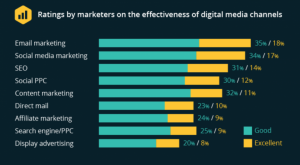If there’s anything you should have learned anything from 2015, it’s that substance over keywords is the new direction. There’s an even more important lesson you need to learn in 2016. Looking ahead to the future of SEO, there are a number of trends that are going to change how we think about optimizing websites for search.
SEARCH INFLUENCERS IN 2016
- Social Signals
- Location
- Mobility
- Authority
- Language
ENLISTING A HUMAN-CENTRIC MARKETING APPROACH
As Neil Patel (@neilpatel) said, “The future of marketing is human-centered. Without this focus, you’re just contributing to the noise. But those who approach research, writing, marketing, and sales from the user’s perspective will always thrive.”
This continued focus on the individual ensures that search engines continue to reward those that focus on providing the best value to the human user. The biggest step to getting your SEO & content marketing efforts aligned for 2016 is to stop and ask the question:
What are my customers’ greatest needs and how can I meet them?
In order to answer the question above we are going to examine the 5 factors currently contributing the most to search. These are the five factors everyone must consider for SEO success in 2016.
SYMBIOSIS OF SEARCH & SOCIAL MEDIA
Though Google has said it does not use the number of Twitter followers or the number of likes a Facebook Page has as a ranking signal, a strong presence on social media can still be an integral part of any SEO program.
In February of 2015, Google and Twitter struck a deal to allow Google access to the “firehose” of all Tweets. The firehose as it’s called is the entire stream of tweets, all 500 million per day. While all the tweets aren’t being indexed, the importance of social media to Google can’t be underestimated.
On May 19, 2015 Google announced they would be rolling out indexed Tweets on mobile searches. By the end of August of 2015 Tweets were incorporated into desktop and all English language searches. Studies of Google’s Tweet indexing has shown that the volume of indexed Tweets has grown rapidly in the months since it was first adopted. A report in July showed an increase of 466% in the last four months.
As indexed social media posts continue to take more room on the first page of results, it is important for brands to have a social media presence across multiple platforms, or they could find themselves losing traction in the search engine results page (SERP).
FOCUS ON LOCALIZATION
As Google’s algorithms get better at understanding the intent behind a search, the ability to provide clear, unambiguous information on a business will become of increased importance. Many local businesses have seen changes in their organic results since August’s Snack Pack update.
One area that will continue to see tremendous growth is local searches and mobile usage. This trend can end up being a benefit for both local businesses and national brands, as the increased use of local searches coupled with the growth of Google returning rich answers makes an important case for startinga local search SEO program.
THE RISE OF MOBILE
Arguably the biggest SEO news of 2015 was the announcement from Google in April that mobile-readiness would become a ranking factor for search results. This update, sometimes referred to as Mobilegeddon, is a clear signal from Google that the future of search lies in mobile. With mobile search now more prevalent than desktop, optimizing for mobile will only grow in importance.
THE DECLINE OF KEYWORDS AND THE RISE OF INTENT
Though we constantly hear about the decline of keywords, they continue to play an important role in SEO. 2016 will see the continued evolution of the best content meeting the context of a person’s search instead of being optimized for a specific keyword.
Throughout 2016 we will find ranking for one specific keyword will continue to provide less and less value. In order to succeed in SEO in 2016, it’s going to be necessary to focus on providing a quality answer to match the intent behind a search.
Brands that perform better data-driven research into understanding their user will likely receive the growing share of organic traffic.
CREATING DATA-DRIVEN HUMAN-CENTERED CONTENT
In addition to a renewed emphasis on mobile, Google’s own testers look individually at a site’s mobile experience “analyzing the page’s expertise, authoritativeness and trustworthiness” or the lack thereof. According to Google, you want to make sure your content is not only quality content but that it“highlights any expertise, that the author of the content is some servant authority on the subject, and if the site as a whole is trustworthy or not.”
In a recent Content Marketing Institute survey, 69% of B2B marketers said they plan to focus on creating high-quality engaging content. Considering the exponential growth of the amount of content found online, it’s safe to say that only content of the highest value and usefulness is going to work.
The time of short “me too” posts that provide zero value is gone. Throughout 2015, we saw several Google updates designed to reward sites that provide the highest-value content.
HOW TO DETERMINE WHAT’S QUALITY CONTENT
Peep Laja (@peeplaja) of ConversionXL, who blogs in a highly competitive niche, says a normal blog post for him takes approximately 18 hours to create. While this seems like a tremendous investment for one piece of content, it is important to remember that you can re-use high-quality content to produce results multiple times.
High-quality content is something that provides value to a person who consumes it. Different types of content provide different levels of value, and it is up to you to determine the most effective use for it. Also, it is important to remember that the message you’d like to convey with your content will not necessarily stick the first time around.
As Steve Luvender (@bite), Liquid’s Senior UX Architect, explained in It Takes 7 Credits to Resonate: “one of the greatest values to creating high-quality content is that if done correctly, it can be used multiple times across different platforms.”
YOU KNOW LINK BUILDING ISN’T A THING ANYMORE
Things used to be simple; you could publish a page and then point a bunch of links to it and suddenly it was ranking for what you wanted it to rank for. That’s not the case anymore. The time of “just getting” links has passed; in 2016 it’s all about earning links.
Google has become very particular about the types of links that it uses for ranking purposes and in fact the less valuable links are commonly being penalized.
The Google Penguin update, expected in early 2016, will continue to focus on the quality and type of links that point to a website. With this new rollout, the update will run in real-time, meaning that ill-gotten links will become apparent more quickly and penalized as such.
YOU CAN BECOME AN AUTHORITY
It has been mentioned that Google is putting a focus on understanding whether or not the author of a particular piece of content is an authority on the subject. Though Google no longer includes Author information within search results, the tag is still used to help establish content producers as thought leaders. Seeing the same author consistently produce valuable content gives weight to that author in search engines.
As Mark Traphagen (@marktraphagen) notes, “We often see major, well-known brands dominating the top results for commercial queries because user behavior data tells Google that’s what people want to see. In a similar way, people might be happy to be led directly to authors they already know and trust.”
As the change from keywords to semantic searches continues, it will be of continued importance for search engines to understand how to rank who is an authority on a subject.
THE IMPORTANCE OF CONTEXT
One of the biggest announcements during 2015 was Google’s official announcement of RankBrain, a part of Google’s overall Hummingbird algorithm. RankBrain demonstrated that Google’s goal is to better understand the intent behind each particular search.
As of mid-November, Google was reporting that they can now better understand complex natural language searches. This is going to become increasingly important as more people switch to doing searches on their phones using language rather than keystrokes.
Adam Stetzer (@hubshout) provides an excellent definition of RankBrain, “Think of RankBrain like a clerk at Bed Bath and Beyond. If you walk into the store and say that you’re looking for “that plastic doohickey that squeezes the juice from a lemon without getting any seeds in the vinaigrette,” the clerk – or the AI – will synthesize that string of words and respond, “Oh, a citrus squeezer? Those are in Aisle 11; follow me.”
STRUCTURED DATA IS THE NEW BLACK
We have begun to see results on how adding structured data to important web pages can lead to increased organic reach. Recently we were able to implement structured data on a client’s e-commerce site leading to increased click-through rates and organic revenue. It is also important to note, Google made announcements that they plan to expand structured data to include more features in 2016.
YOU CAN DO A SEARCH EVERYWHERE
Search engines are everywhere, not just at google.com. For example: on YouTube there are over 3 billion searches a month, users on Twitter perform over 2 billion searches a day, and Amazon searches can amount to as many as 1.1 million per second.
The number of monthly searches on YouTube is more than AOL, Yahoo and Bing combined, and the trend of searches being done outside of search engines and within other platforms is expected to grow.
So when you’re thinking about your website’s search visibility, take into consideration the number of platforms you can potentially be visible on.
CONCLUSION
The outlook for SEO in 2016 is bright. The most important step you can take in 2016 is to ensure that your focus is on your customer. Consistently providing highly useful content that improves a customer’s experience with your brand is your single best step to maintaining success in 2016 and beyond.
I’ll leave you with a great thought from David Amerland (@DavidAmerland), “It’s taken us the best part of two decades in a new century to understand the value of what we already knew from centuries of accumulated practical knowledge of offline behavior namely that to sell something you have to [have] someone who wants it you also need to make them feel good about themselves in the process and convince them you’re a trustworthy source to buy it from.”
SEARCH OPTIMIZATION IN 2016 – PART 1
SEARCH OPTIMIZATION IN 2016 – PART 2
This post can be found on the Liquid Interactive Blog: 5 Things to Know About SEO in 2016.
Digital & Social Articles on Business 2 Community(40)







